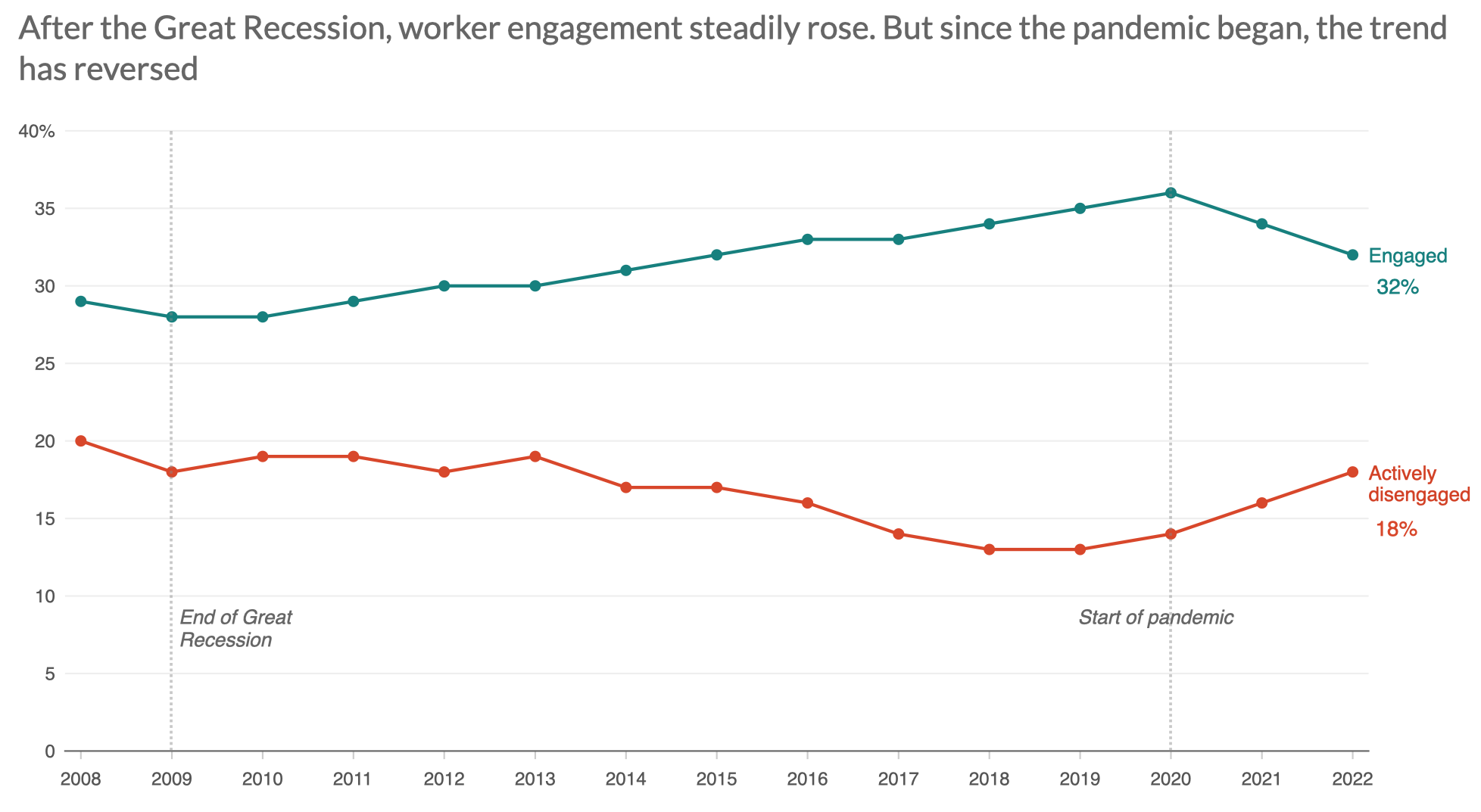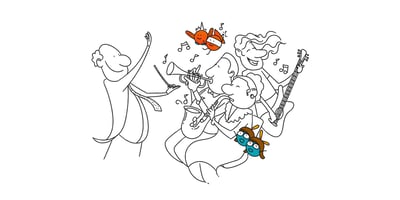AI tools will allow humans to do what we do best: Work creatively

The lightning speed with which artificial intelligence (AI) has progressed in 2023 has caused mixed reactions. Many are excited about the possibilities it'll unlock. Others are concerned about its impacts on humans, especially when it comes to work.
This feeling of unease is understandable. In previous technological paradigm shifts, when the nature of work changed, it gave rise to new jobs that people couldn’t imagine before. When industrial robots were deployed to help make cars in the 1960s, new roles were created to supervise those robots. Experts thought that automated teller machines (ATMs) would replace up to 75% of human tellers—instead, banks invested the savings from the machines to build more branches and create new teller jobs. Similarly, the arrival of advanced AI like large language models (LLMs) has paved the way for novel professions such as prompt engineering.
Broadly speaking, new technologies have made workers more productive, and contributed to greater economic growth. Anxiety about AI replacing jobs is understandable, but in several ways, the technology is making people more valuable than ever.
Rehumanizing work
Despite all the talk about AI making workers obsolete, human labor has never been more valuable. As Bain & Company points out, “amid decelerating labor force growth, superabundant capital, and the growing importance of intangible assets like intellectual property and customer networks, the balance of power is shifting from capital to labor. Today’s firm requires a new mental model, one that rehumanizes the way we think about work.”
Automation has been taking the robot out of the human for some time now, and recent advances in AI point to a future where software robots can take on an even greater share of non-creative work. A study by “researchers from the University of Pennsylvania and OpenAI found some educated white-collar workers earning up to $80,000 a year are the most likely to be affected by workforce automation.” This finding underscores the urgent need to redefine our perspective towards work and automation.
The report from Bain goes on to say that, going forward, successful companies “will stop managing workers like machines, instead supporting them to build personal capacity and create a career that matches their individual idea of a meaningful life. As part of this, leaders will reorganize workflows to help individuals best utilize their uniquely human advantages.”
It’s understandable to be nervous about an uncertain future, but the prospect of a more fulfilling career should be exciting, too. After all, for many, the rewards of a job go beyond a paycheck.
Work can be more than just a living
In the early 20th century, influential thinkers predicted that improvements in technology would reduce the working week to as little as 15 hours. Well, we know how that turned out. Despite significant technological advances, employees in most developed countries still average 35 working hours or more per week.
While some see this as a failure, I think it points to an under-talked about aspect of work. Even when they have enough money to support themselves, many people choose to keep working, since it gives them other benefits such as purpose and belonging. In fact, a survey of European employees showed that 55% would continue working even if they could afford not to.
Clearly, this doesn’t apply to everyone, especially those with roles that lack creativity and autonomy. In the United States (U.S.), less than one-third of employees are actively engaged in their jobs. Globally, just 20% of employees report feeling engaged at work.

Source: NPR
There are a number of reasons why workers may not feel connected to their jobs. However, research generally shows a positive correlation between creativity and engagement. Furthermore, AI tools are increasing the value of human creativity and allowing employees to spend more time on satisfying work.
Breaking down technical barriers to creativity
For as long as computers have existed, coding has been a necessary skill for creating software. But that’s changing with generative AI tools—users can now describe the programs they want to create using everyday language, allowing people without technical skills to tap into their creative potential. These advances are building on no-code tools such as UiPath StudioX, which enables citizen developers to build powerful automations rapidly. Project “Wingman” for UiPath Studio Web is an upcoming generative AI capability that allows users to create automations quickly from text-based descriptions.
Proponents of the ‘no-code’ A.I. revolution believe it will change the world: It used to require a team of engineers to build a piece of software, and now users with a web browser and an idea have the power to bring that idea to life themselves.
Craig S. Smith, Contributor, The New York Times
Going forward, the creative thinking required to come up with useful software will be a significant value-add that humans can provide. The current generation of LLMs work by scraping the internet to make informed guesses based on user questions, but they can’t generate truly original ideas like humans can.
No matter how impressive a piece of computer-created poetry or artwork might be, it’s always built from blocks carved out of the data that’s used to train it. In other words, it isn’t genuinely capable of what we would call ‘original thought’ – having new ideas of its own.
Bernard Marr, Contributor, Forbes
By removing the technical barrier between having a new idea and making it real, millions of people without technical training will be able to harness their creativity to create new products and services. As Andrej Karpathy, one of the world’s leading AI experts, has said, “The hottest new programming language is English.”
There’s still a lot to figure out
Every day, new developments bring us closer to an AI-powered future. But many experts in the field are worried that the technology is moving so quickly that necessary ethical and safety considerations aren’t able to keep up.
In an effort to give governments, companies, and other stakeholders a chance to talk about the implications of these massive advancements, a group of influential AI experts signed a letter calling on “all AI labs to immediately pause for at least 6 months the training of AI systems more powerful than GPT-4.” This, they argued, would help refocus “on making today's powerful, state-of-the-art systems more accurate, safe, interpretable, transparent, robust, aligned, trustworthy, and loyal.”
Organizations are recognizing the urgency of this issue. A company in California recently launched the first “Firewall for LLMs,” which offers tools to protect users and organizations from AI safety risks. If we’re smart enough to create powerful generative AI tools, we should be able to make sure they align with “Responsible AI” principles.
Plus, there are deeper questions we all need to think about, such as the value of human creativity. Stable diffusion programs DALL-E and Midjourney were the target of a lawsuit by a group of artists who claim that these tools were trained by billions of images across the web “without the consent of the original artists.” Existing copyright law wasn’t designed with AI in mind, and the industry is waiting to see how the legal system treats this issue. Is there a unique type of value in the time, effort, and creativity required to hand-produce a piece of art, versus taking a “short cut” and having an AI create one in seconds?
These are just a few of the host of questions facing the AI world. To make sure we get it right, we’ll need to consider the voices of all stakeholders.
Uncertainty is a part of progress
Part of the excitement around new technologies is that nobody really knows where it’s all going. Thomas Watson, former president of IBM, infamously said in 1943 that he thought “there is a world market for maybe five computers.”
As history shows, humans aren’t very good at predicting the future. Time and again, we’ve thought that new technologies would replace human labor entirely, while up to this point they’ve largely created new, better jobs. That being said, it's essential to have open discussions about the opportunities and challenges AI presents, while also addressing ethical and safety concerns. This technology is more powerful than anything we’ve seen before, and we should proceed with caution.
Yet while these concerns are valid, AI presents an enormous opportunity to redefine our relationship with work and unlock human creativity. By adopting a more human-centric approach to work and breaking down technical barriers, we can harness the power of AI to make work more engaging and fulfilling for everyone.
The future may be uncertain, but it's also ripe with possibilities. Together, we can navigate this new world and create a future where technology empowers and enriches our lives. To explore more about what’s possible with AI and automation, view the on-demand session recordings from UiPath AI Summit.
Technology Evangelist for Document Understanding, UiPath
Get articles from automation experts in your inbox
SubscribeGet articles from automation experts in your inbox
Sign up today and we'll email you the newest articles every week.
Thank you for subscribing!
Thank you for subscribing! Each week, we'll send the best automation blog posts straight to your inbox.



